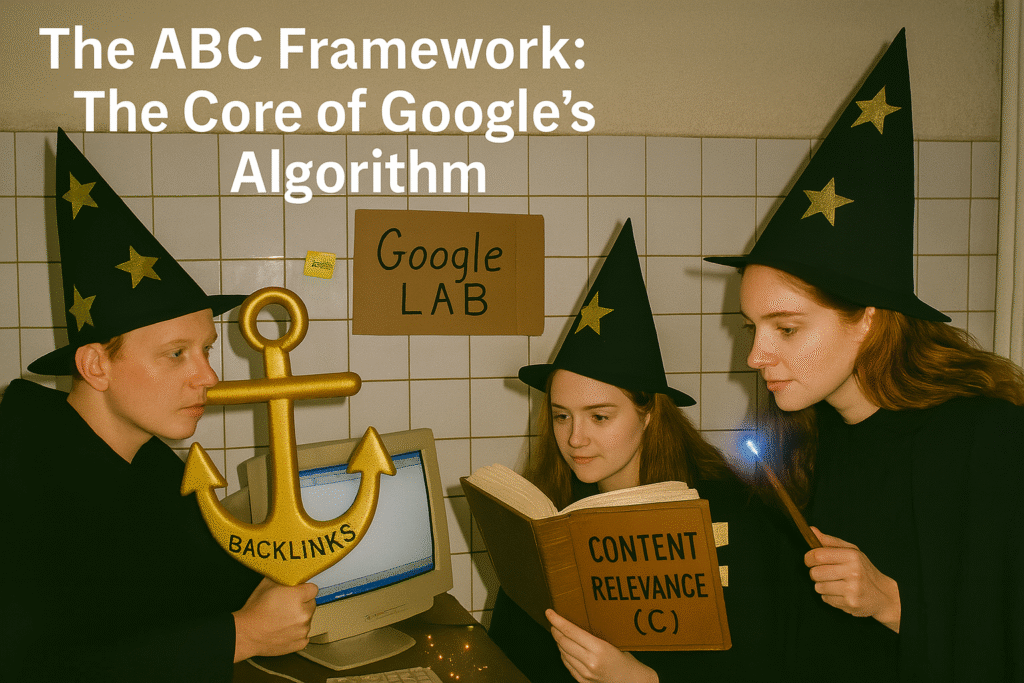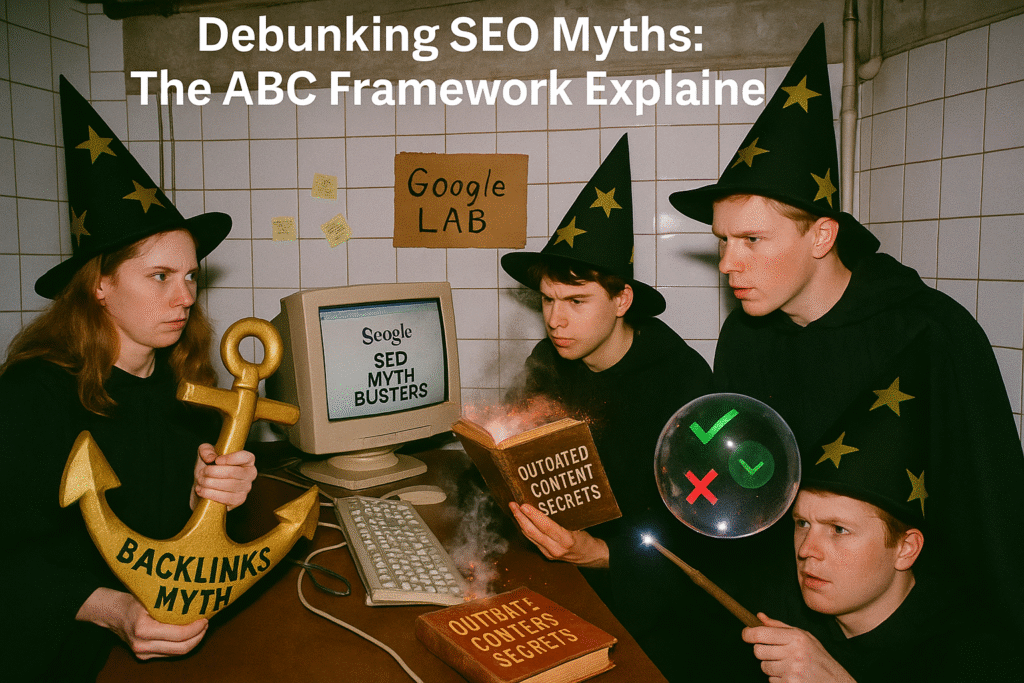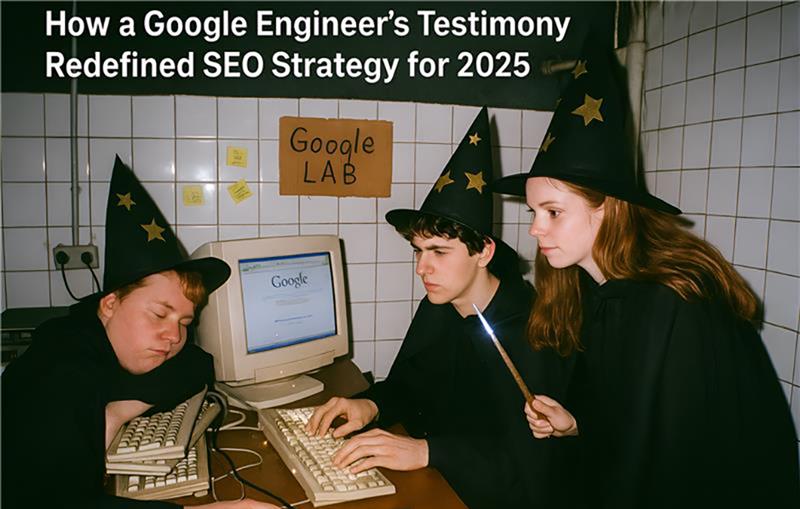In a revealing court testimony, a Google engineer disclosed critical details about how Google’s search ranking algorithm operates, challenging the complexity often peddled by SEO “experts.” The testimony, from a U.S. Department of Justice (DOJ) antitrust trial, introduced the “ABC framework” as the core of Google’s ranking system and confirmed that quality scores are static, emphasizing site-wide authority over individual page optimization. This blog dives deep into these insights, offering practical, actionable strategies to optimize your website for 2025 and beyond. Drawing from verified sources like DOJ documents and expert analyses, we’ll explore the framework, its implications, and how to apply it effectively without fluff or jargon.
The ABC Framework: The Core of Google’s Algorithm

Google’s ranking algorithm hinges on the “ABC framework,” a trio of signals that determine a page’s “topicality” – how relevant it is to a user’s search query. These signals are:
‣ Anchors (A): Backlinks from external websites to your page. Quality matters more than quantity; links from authoritative, relevant sites signal trustworthiness. For instance, a backlink from a leading industry publication like TechCrunch carries more weight than dozens from low-quality directories. The DOJ testimony highlights that anchors contribute to Google’s PageRank, a signal measuring link distance from trusted “seed sites.”
‣ Body (B): The relevance of your content to the search query. Google assesses how well your page addresses user intent – whether informational (e.g., “how to bake bread”), navigational (e.g., “Facebook login”), or transactional (e.g., “buy running shoes”). High-quality content that directly answers the query ranks better. The testimony notes this is evaluated through hand-crafted algorithms, not just AI models.
‣ Clicks (C): User engagement, specifically dwell time – how long users stay on your page before returning to the search results (SERP). Longer dwell times suggest valuable content, while quick bounces indicate a mismatch with user expectations. The DOJ documents confirm Google uses click data, including Navboost, to refine rankings based on user interactions.
These signals combine to form a topicality score (T*), a hand-crafted metric developed over five years to ensure relevance. Unlike machine learning-heavy systems used by competitors, Google’s approach allows engineers to fine-tune rankings for transparency and accuracy.
Static Quality Scores: Why Site-Wide Authority Matters

A groundbreaking revelation from the testimony is that Google’s quality scores (Q*) are static, meaning a site’s trustworthiness is assessed at the domain level and applied across all related content. Introduced 17 years ago to combat content farms, this score doesn’t fluctuate per query, making site-wide authority a critical focus. Key points include:
‣ Domain-Level Trust: A high Q* score benefits all your pages, not just those individually optimized. For example, a trusted news site like The New York Times enjoys a ranking boost across articles due to its established authority.
‣ Consistency Over Tweaks: Instead of micro-optimizing single pages, prioritize signals that elevate your entire site’s reputation, such as consistent expertise, high-quality backlinks, and user engagement metrics.
‣ Chrome Data Influence: The testimony and leaked documents suggest Google uses Chrome browser data (e.g., site visits and engagement) to assess site-wide authority, contradicting earlier claims that Chrome data isn’t used for rankings.
This static quality score, or Q*, integrates with the ABC framework and other signals like PageRank and Navboost to form a comprehensive ranking system. It underscores the need for a holistic SEO strategy.
Beyond ABC: Additional Ranking Signals
While the ABC framework is central, Google’s algorithm includes other signals that complement it, as revealed in the testimony and related leaks:
‣ Navboost: A click-based signal that tracks user interactions like clicks, hovers, and swipes to refine rankings. It’s described as “one of the important signals” for assessing relevance.
‣ DeepRank: An LLM-based system using BERT to decompose complex signals for transparency. It enhances Google’s ability to understand content context, especially for nuanced queries.
‣ PageRank Variants: Google uses multiple PageRank types, including PageRank_NS (Nearest Seed), which evaluates link distance from authoritative sites within a topic cluster. This reinforces the importance of relevant, high-quality backlinks.
‣ Information Satisfaction (IS): A top-level metric that evaluates overall SERP quality. Human raters score pages based on helpfulness and trustworthiness, fine-tuning algorithms like RankBrain and RankEmbed BERT. IS underscores Google’s focus on user satisfaction.
These signals, while complex, align with the ABC framework’s focus on relevance and quality, but they highlight the layered nature of Google’s algorithm.
Actionable SEO Strategies for 2025 & 2026
To leverage the ABC framework and static quality scores, implement these practical, no-nonsense strategies:
1. Secure High-Quality Backlinks
‣ Why It Matters: Backlinks (Anchors) are a vote of confidence. The testimony confirms their role in PageRank and Q* scores. High-authority links from relevant sites outweigh numerous low-quality ones.
‣ How to Do It:
- ➺ Reach out to industry publications for guest posts or mentions.
- ➺ Create link-worthy content, like original research or in-depth guides.
- ➺ Use tools like Semrush’s Link Building Tool to identify and contact relevant sites.
- ➺ Example: A fitness blog could pitch a guest post to Men’s Health, linking back to a detailed workout guide.
‣ Action This Week: Audit your backlink profile with Ahrefs or Moz. Disavow toxic links and prioritize outreach to 5–10 high-authority sites in your niche.
2. Align Content with Search Intent
‣ Why It Matters: The Body signal ensures your content matches what users seek. Google’s language models, refined over five years, prioritize intent-driven content.
‣ How to Do It:
- ➺ Analyze top-ranking pages for your target keywords to identify intent (e.g., listicles for “best tools,” tutorials for “how to” queries).
- ➺ Use Google’s “People Also Ask” and related searches to uncover user needs.
- ➺ Example: For “best CRM software,” create a comparison table with pros, cons, and user reviews, not just a product list.
- ➺ Incorporate semantic search principles by covering related subtopics comprehensively.
‣ Action This Week: Review your top 10 pages in Google Search Console. Update 2–3 pages to better align with intent, adding visuals or FAQs.
3. Maximize User Engagement
‣ Why It Matters: Clicks (dwell time) signal content value. The testimony confirms Navboost uses click data to refine rankings, and Chrome data tracks site-wide engagement.
‣ How to Do It:
- ➺ Improve readability with clear headings, short paragraphs, and visuals like infographics or videos.
- ➺ Add interactive elements, such as calculators or quizzes, to increase dwell time.
- ➺ Example: A recipe site could include a step-by-step video to keep users engaged longer.
- ➺ Optimize for mobile to reduce bounce rates, as mobile-first indexing is standard.
‣ Action This Week: Check Google Analytics for pages with high bounce rates or low time on page. Revamp 1–2 pages with multimedia or improved structure.
4. Build Site-Wide Authority
‣ Why It Matters: Static Q* scores mean your site’s overall reputation impacts all pages. Consistent expertise and trustworthiness signals are critical.
‣ How to Do It:
- ➺ Create Content Hubs: Build clusters of 10+ interlinked pages around a core topic to establish topical authority. For example, a SaaS site could create a hub on “project management” with articles on tools, techniques, and case studies.
- ➺ Showcase Expertise: Add detailed author bios with credentials, link to original research, and include client testimonials or case studies across your site.
- ➺ Earn Brand Mentions: Get featured in industry podcasts, blogs, or roundup articles to boost your site’s reputation.
- ➺ Example: A health site could publish a study on nutrition trends, cited by other blogs, to enhance its Q* score.
‣ Action This Week: Map out a content hub for one key topic. Draft a pillar page and 3–5 supporting articles, ensuring internal links and expertise markers.
5. Optimize Technical Performance
‣ Why It Matters: While not part of ABC, technical factors like page speed and mobile-friendliness influence engagement and rankings. Slow sites increase bounce rates, hurting the Clicks signal.
‣ How to Do It:
- ➺ Use Google’s PageSpeed Insights to optimize load times, focusing on Core Web Vitals (e.g., Largest Contentful Paint, First Input Delay).
- ➺ Ensure mobile responsiveness, as Google uses mobile-first indexing. Test with Google’s Mobile-Friendly Test.
- ➺ Fix broken links and ensure a clean sitemap to aid crawling.
Debunking SEO Myths

The testimony dispels several myths perpetuated by the SEO industry:
‣ Myth: Google Uses 200+ Ranking Factors Equally: While Google employs thousands of signals, the ABC framework and Q* are core to topicality and trust. Focus on these over minor factors like keyword density.
‣ Myth: Domain Authority Is a Google Metric: Google doesn’t use third-party metrics like Moz’s Domain Authority, but Q* and siteAuthority serve similar purposes internally.
‣ Myth: Page-Level Optimization Is Enough: Static quality scores mean site-wide signals are critical. A single high-quality page on a low-trust site may struggle to rank.
Why This Matters for 2025 & 2026
The DOJ testimony, corroborated by several sources, simplifies SEO to its essence: deliver relevant, trustworthy content that users value. The ABC framework and static quality scores shift the focus from chasing countless factors to building a cohesive, authoritative site. Google’s emphasis on user satisfaction (via IS scores) and Chrome data further underscores the need for a user-first approach.
Recent algorithm updates, like the August 2024 Core Update, reinforce this by prioritizing high-quality, people-first content and penalizing spammy tactics. By aligning with these insights, you can future-proof your SEO strategy against evolving algorithms.
Implementation Plan for This Week
Start applying these insights immediately with this checklist:
- ➺ Audit Trustworthiness: Review your site for expertise markers (e.g., author bios, citations). Add or update on 5+ key pages.
- ➺ Check Engagement: Use Google Analytics to identify pages with high bounce rates or low dwell times. Optimize 2–3 pages with visuals or interactive elements.
- ➺ Evaluate Backlinks: Use Ahrefs or Moz to assess your backlink profile. Reach out to 5 relevant sites for guest posts or mentions.
- ➺ Map Content to Intent: Analyze top-ranking pages for your target keywords. Update 2–3 pages to better match user intent.
➺ Fix Technical Issues: Run a Site Audit to identify slow pages or mobile issues. Address at least one critical error.
Conclusion
The Google engineer’s testimony unveils a clear, actionable truth: effective SEO boils down to quality backlinks, relevant content, and strong user engagement, underpinned by site-wide authority. By focusing on the ABC framework and building a trustworthy site, you can achieve lasting rankings in 2025. Whether you’re optimizing backlinks, crafting intent-driven content, or enhancing engagement, these strategies align with Google’s user-first approach. For expert guidance, Mindbees’ Search Engine Optimization services can strengthen your backlink profile and technical performance, while our Content Marketing expertise ensures your content hubs resonate with users and search engines alike. Partner with Mindbees to implement these insights and transform your site’s performance today. Start with this week’s checklist and watch your rankings soar.

